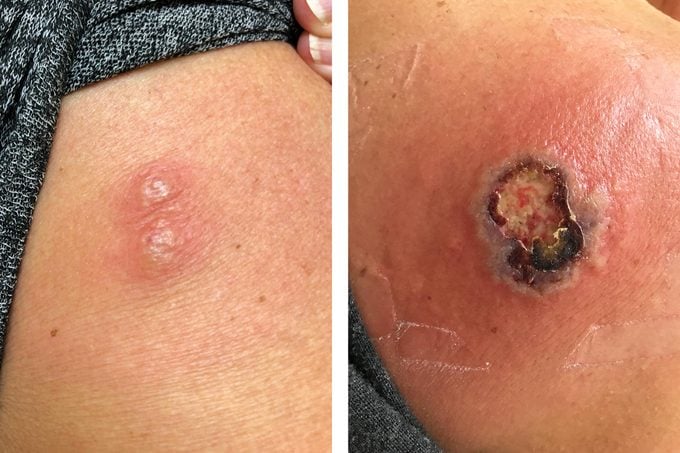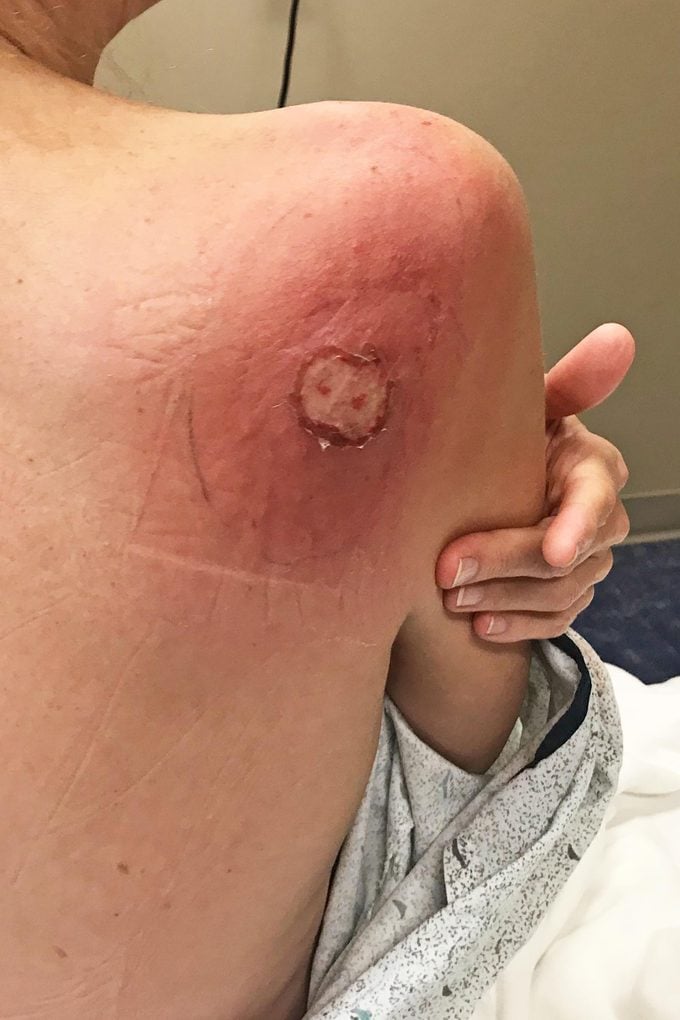How One Woman Almost Died from Two “Spider Bites”
Updated: May 12, 2020
Her doctor dismissed the marks as "spider bites," but the reality was more serious.

Ready to embrace life as an empty nester, Mary (not her real name) had big plans for her weekend. The magazine art director had recently sent her youngest kid off to college. Now, she was ready to tackle a big project in her New Jersey home: cleaning out her unfinished basement. Over that fateful weekend in October 2018, Mary hauled out old furniture and boxes that had sat among cobwebs for years. Little did she know that her project would nearly take her life.
On the following Monday, Mary noticed two small bumps on her shoulder blade. They looked like spider bites, but she wasn’t too worried. However, when she woke up on Tuesday, Mary found that just touching the bumps triggered excruciating pain. “Within 12 hours of finding the bumps, they were so painful. It was agony to touch them at all, and it felt like knives stabbing me when I pressed on them,” she says. “I knew the pain was far too great to be only a spider bite.” Her doctor prescribed antibiotics, but Mary wondered if that would be enough to treat whatever was wrong with her.
When she awoke on Wednesday, Mary was sweating profusely and unable to get out of bed. The two small bumps on her back had grown to the size of silver dollars. Worse, they had turned black. A friend who saw her that day begged her to go to the emergency room, but Mary declined: “I had a follow-up appointment with my doctor the next day, and I dismissed the idea. I shouldn’t have.” On Thursday, the bumps erupted; as she sat in the waiting room of the doctor’s office, her shirt clung to the oozing wounds.
“I just wasn’t thinking clearly—I didn’t know how sick I was,” she says. When the doctor examined Mary again, he advised her to wait another day to see if the spots grew larger. When the doctor left the room, the nurse pulled Mary aside and urged her to go straight to the emergency room. “She saved my life,” Mary says, thinking back. “She told me it was getting larger, it was black, and it was aggressive. I’m so glad she was there.” These are the 9 signs of an infected cut or scrape you should never ignore.

The ER staff checked Mary in right away and began running tests. That’s when she got startling news: Her blood work revealed that a serious staph infection had entered her bloodstream and that she was in sepsis—a bodywide reaction to severe infection. She was experiencing classic signs, such as fever, low blood pressure, rapid heart rate, and confusion. Typically, those at the highest risk for sepsis are over 65 or have chronic medical issues such as cancer, diabetes, or a condition that weakens the immune system. However, Mary is more than a decade younger than 65 and in excellent health; her case demonstrates that anyone can develop this life-threatening reaction. The bacteria responsible for Mary’s sepsis—Staphylococcus aureus—is common and can cause boils and other minor skin infections; for an unlucky few, it leads to major trouble, even death. Watch out for the 11 signs of sepsis you need to know.
“As soon as I got the diagnosis, they put me on an IV,” Mary says. “When I asked what the medication was for, they said it was to protect my kidneys. I had no clue how serious sepsis was—or even what it was—at the time.” A quick Google search on her phone alerted Mary to the danger: “I realized this kills people—and I have it.” Mary stayed on intravenous antibiotics for three days before she was discharged from the hospital. She had to take two strong antibiotics for an additional ten days to clear the infection.
“I still have no idea how I contracted the staph infection, but looking back, I wish I had listened to all of the little alarm bells going off in my head telling me something was off,” Mary says. “We have to listen to our body—it tells us when we need help.” Next, read up on 15 more silent signs your body may be in big trouble.

















